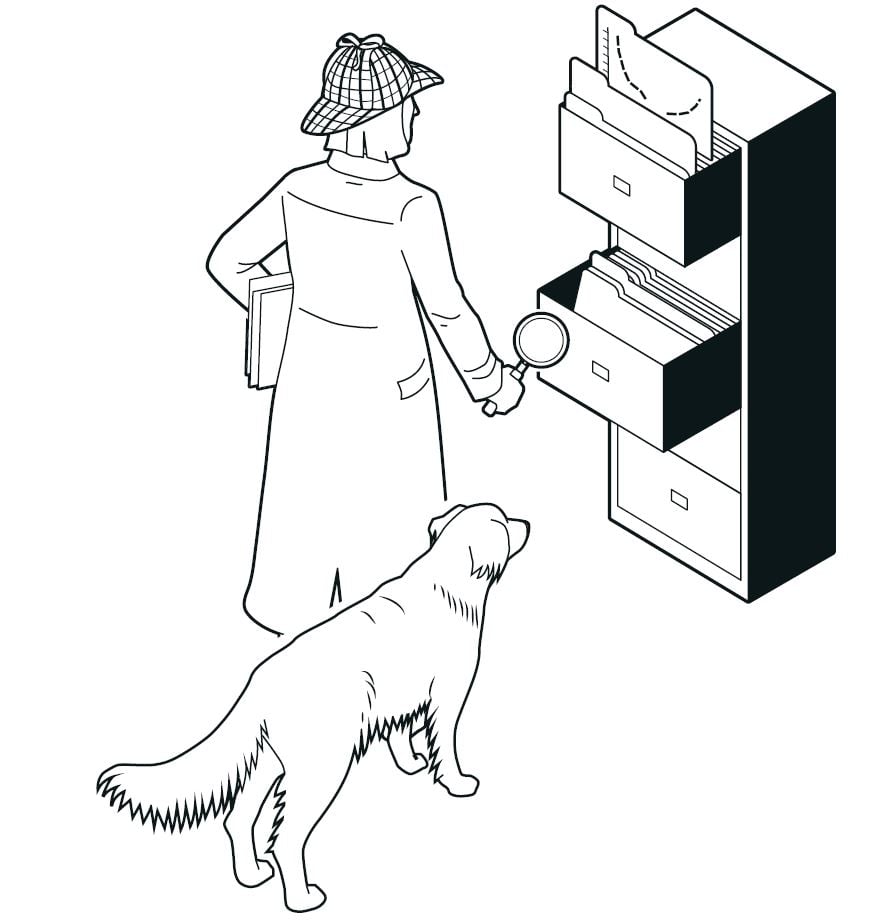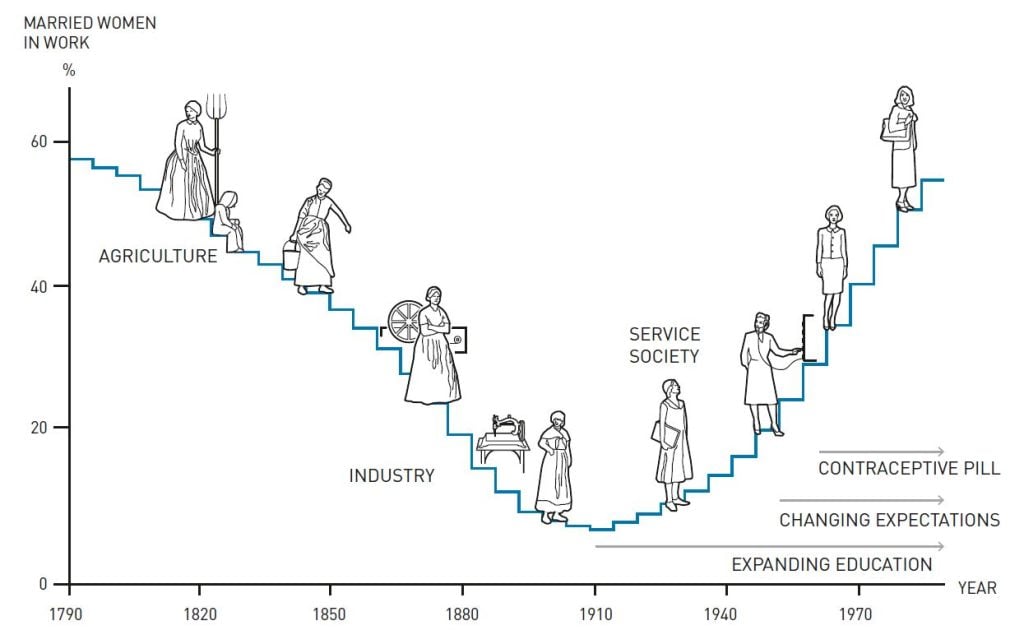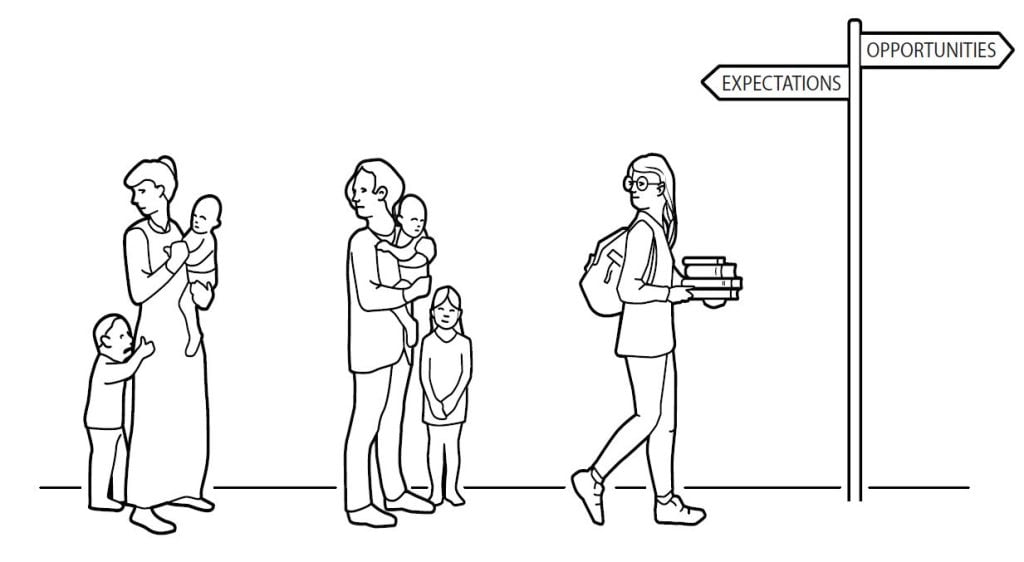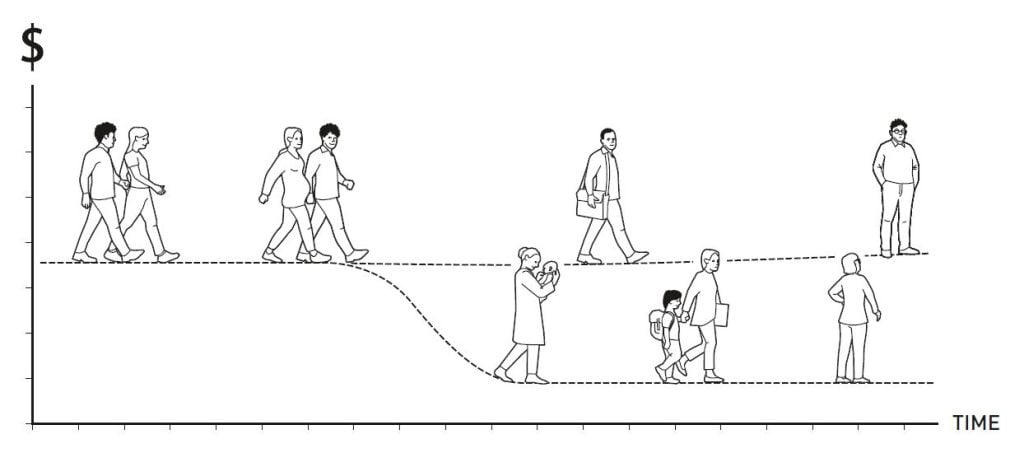Popular information
Popular science background:
History helps us understand gender differences in the labour market (pdf)
Populärvetenskaplig information:
Historien hjälper oss förstå könsskillnader på arbetsmarknaden (pdf)

The Prize in Economic Sciences 2023
Over the past century, the proportion of women in paid work has tripled in many high-income countries. This is one of the biggest societal and economic changes in the labour market in modern times, but significant gender differences remain. It was first in the 1980s that a researcher adopted a comprehensive approach to explaining the source of these differences. Claudia Goldin’s research has given us new and often surprising insights into women’s historical and contemporary roles in the labour market.
History helps us understand gender differences in the labour market
Globally, around half of all women are in paid employment, while the equivalent figure for men is eighty per cent. When women work, they usually earn less. Understanding how and why levels of employment and earnings differ between women and men is important for socioeconomic reasons, in both the short and long run, because the issue relates to the most efficient use of society’s resources. If women do not have the same opportunity to participate in the labour market, or they participate on unequal terms, labour and expertise are wasted. It is economically inefficient for jobs not to go to the most qualified person and, if pay differs for performing the same work, women may be disincentivised to work and have a career. By combining innovative methods in economic history with an economic approach, Goldin has demonstrated that several different factors have historically influenced – and still influence – the supply of and demand for female labour. These include women’s opportunities for combining paid work and a family, decisions relating to education and childrearing, technical innovations, laws and norms, and the structural transformation of the economy. In turn, her results have enabled a better understanding of how and why rates of employment and pay differ between women and men. To achieve these insights, Goldin looked back over two hundred years.

In the rearview mirror
Over the last few centuries, society has experienced significant political, social and technological changes. Contemporary industrialised countries have enjoyed steady economic growth since the industrial revolution. It would be easy to believe that women’s participation in the labour force would follow the same trend, but Goldin’s research has shown that this is not the case.
Looking in the rearview mirror, she has created an understanding of how women’s circumstances changed as the economy was transformed from a traditional agrarian economy to contemporary society. However, some parts of this mirror were smudged, due to women’s work being underreported in historical sources, and these smudges needed wiping away. When this was done, Goldin could allow the overall picture to emerge by analysing both the corrected and new historical data. When she zoomed in on US history, this picture became crystal clear – she was able to identify groundbreaking patterns that have not only challenged existing knowledge, but which have also changed the view of women’s historical and contemporary roles in the labour market. One of these patterns looked like the letter U.
The U-shaped curve
Before Goldin’s pathbreaking book was published in 1990, researchers had mainly studied data from the twentieth century and concluded that there was a clear positive association between economic growth and the number of women in paid employment. In other words, as the economy grew, more women were in work. However, because older data had barely been studied, this relationship remained unclear over a longer period of time.

Goldin’s first observation was that women’s employment rates had often been incorrectly stated in existing data. For example, it had once been common for women’s occupation to be designated as “wife” in censuses and public records, but even if they were married it was not automatically the case that they did no work other than domestic labour. The fact is that it was not unusual for women to work alongside their husbands in agriculture or various forms of family business. Women also worked in cottage industries or production in the home, such as with textiles or dairy goods, but their work was not always registered correctly in the historical record. By compiling new databases using historical time-use surveys, industrial statistics and censuses, Goldin was able to correct the data on women’s participation in the labour market. She established that the proportion of women in the US labour force was considerably greater at the end of the 1890s than was shown in the official statistics. For example, her corrections demonstrated that the employment rate for married women was almost three times greater than that registered in censuses.
By uncovering data all the way back to the end of the eighteenth century, she was also able to reveal a surprising new historical fact: prior to the rise of industrialisation in the nineteenth century, women were more likely to participate in the labour force. One reason for this was that industrialisation made it harder for many married women to work from home and so combine work and family. Goldin documented this in an innovative manner, using data from over ten thousand female household heads in eighteenth-century Philadelphia. Even if Goldin was able to show that many unmarried women were employed in manufacturing during the industrial era (in some states, up to forty per cent of all young women worked in industry), the total female labour force declined.
Along with the previously known increase at the start of the twentieth century, Goldin showed that women’s historical participation in the US labour force could be described using a U-shaped curve for the two-hundred-year period from the end of the eighteenth century. Because economic growth was steady throughout this period, Goldin’s curve demonstrated that there is no historically consistent association between women’s participation in the labour market and economic growth.
We now know that this U-shape is in no way unique to the US and holds true in many other countries. These insights make it possible to better map and understand women’s position in the labour market internationally. In other words, we should not count on economic growth automatically reducing gender differences in the labour market. But what explains the differences? Why is equality progressing so slowly? Goldin established that marriage is one important explanation.
Do you take this man to be your lawfully wedded husband?
By the beginning of the twentieth century there was a significant difference in the employment rates of married and unmarried women. While around twenty per cent of all women worked for pay, only five per cent of married women did so. This was also the period of US history in which the upward trend for female participation in the labour market started – where the U-shaped curve turned upward. Goldin showed that technological progress, the growth of the service sector and increased levels of education brought an increasing demand for female labour. However, social stigma, legislation and other institutional barriers limited the influence of these factors. Goldin was also able to establish that marriage played a greater role than had previously been believed.
Goldin noted that legislation known as “marriage bars” often prevented married women from continuing their employment as teachers or office workers. Despite an increasing demand for labour, married women were excluded from parts of the labour market. This type of legislation peaked during the 1930s’ Great Depression and the years following it – but was not the only reason. Goldin also demonstrated that there was another important factor in the slow reduction of the gap between men’s and women’s rates of employment, namely women’s expectations for their future careers.
The importance of expectations
The labour market consists of different generations, cohorts, who faced different circumstances when making their life choices. Goldin developed a cohort-based approach to the analysis of what happens when a cohort enters the labour market. In the early twentieth century, for example, most women were only expected to work for a few years prior to marriage and then to exit the labour market upon marriage, which influenced their educational choices. Goldin showed that in periods of rapid development, women may make decisions based on expectations that later do not come to fruition.

In the second half of the twentieth century, societal changes meant that married women often returned to the labour force once their children were older. The job opportunities they then had were based on educational choices made perhaps twenty-five years previously, at a time when they, according to contemporary social norms, were not expected to have a career. Many women who were young in the 1950s had mothers who were housewives and, when their mothers returned to the labour market, the daughters had already chosen their educational paths. In other words, the daughters did not expect to have a career when they planned their future, and it only became apparent much later that they could have one that was long and active. For much of the twentieth century, women underestimated how much they would work; expectations and outcomes did not start to converge until the 1970s. Consequently, women who were young in that period invested more in their education. In recent decades, women have become increasingly likely to study and, in high-income countries, women generally have a higher level of education than men.
The way that women often left the labour force for an extended period after marriage also explains why the average employment level for women increased by so little, despite the massive influx of women into the labour market in the latter half of the twentieth century. Also, because women who had spent many years at home with their children long comprised a large proportion of the female labour force, the cohort-based approach explains why progress appeared to be slower than it actually was. For example, if participation in the labour market was twenty per cent for one generation and forty per cent for a later generation, the average participation will be thirty per cent (given that the generations are of equal size), despite labour market participation actually doubling between these two generations.
However, even if changing societal norms, new patterns in the labour market and increasing levels of education influenced women’s level of employment, more recent innovations have fundamentally changed their opportunities for both planning and having a career. One of these innovations was a tiny pill.
The power of the pill
Women’s labour market expectations changed at the end of the 1960s, when the pill was introduced – an easy-to-use family planning and contraceptive method women could independently control. By utilising the fact that young women could access the pill in different years in different US states, Goldin and her co-author Lawrence Katz, demonstrated the power of the pill. Goldin found that the pill resulted in women delaying marriage and childbirth. They also made other career choices, and an increasing proportion of women started to study economics, law and medicine. The affected groups were those born in the 1950s, who thus had access to the pill when they were young. In other words, the pill meant that women could better plan their future and thus also be clearer about what they expected, giving them entirely new incentives to invest in their education and careers.
Even if the pill influenced both educational and career choices, this did not mean that the earnings gap between women and men completely disappeared, though it has become significantly smaller since the 1970s. To understand how the earnings gap changed over history, Goldin once again decided to look in the rearview mirror.
Historical earnings gaps
Goldin began by compiling statistics from a range of sources, producing the first long series on the pay gap between men and women. Using materials that covered two hundred years, she was able to demonstrate that many historically important structural changes in the labour market actually benefitted women, long before the issue of equality was a priority. The gender earnings gap lessened significantly during the industrial revolution (1820–1850) and when demand for administrative and clerical services increased (1890–1930). However, despite economic growth, increasing education levels among women and a doubling in the proportion of women working for pay, the earnings gap essentially stayed the same between 1930 and 1980.
Using these statistics, Goldin was also able to show that the pay discrimination (the pay differences that cannot be explained by observed differences in factors such as productivity, education and age) that affected women increased significantly with the growth of the service sector in the twentieth century. Prior to this, women usually worked in sectors where pay was based on piecework; workers in these types of industries, whether male or female, were paid in relation to their productivity. Between the end of the nineteenth century and 1940, the pay difference between men and women that can be attributed to discrimination increased from twenty to fifty-five per cent in the manufacturing industry. In other words, pay discrimination increased, somewhat surprisingly, at the same time as the earnings gap between men and women decreased. One reason for this was that piecework contracts were increasingly abandoned in favour of pay systems based on a monthly wage. Goldin showed that in association with the introduction of modern pay systems, employers tended to benefit employees with long and uninterrupted careers. Expectations thus played a role not just for potential female employees but also their potential employers.
The parenthood effect
We can now see that the earnings gap between women and men in high-income countries is somewhere between ten and twenty per cent, even though many of these countries have equal pay legislation and women are often more educated than men. Why is this? Goldin attempts to answer precisely this question and, among other things, succeeds in identifying one key explanation: parenthood.

By studying how differences in income between men and women changed over time, Goldin and her co-authors, Marianne Bertrand and Lawrence Katz, demonstrated in an article from 2010 that initial earnings differences are small. However, as soon as the first child arrives, the trend changes; earnings immediately fall and do not increase at the same rate for women who have a child as they do for men, even if they have the same education and profession. Studies from other countries have confirmed Goldin’s conclusion and parenthood can now almost entirely explain the income differences between women and men in high-income countries.
Goldin showed that this motherhood effect can partly be explained by the nature of contemporary labour markets, where many sectors expect employees to be constantly available and flexible in the face of the employer’s demands. Because women often take greater responsibility than men for childcare, for example, this makes career progression and earnings increases more difficult. Tasks that are hard to combine with part-time work also make it more challenging to maintain a career for the person in the household, usually the woman, who chooses to reduce their working hours. All these factors have far-reaching consequences for women’s earnings.
A glimpse of the future
By trawling through the archives and compiling and correcting historical data, Goldin has been able to present new and often surprising facts. She has also given us a deeper understanding of the factors that affect women’s opportunities in the labour market and how much their work has been in demand. The fact that women’s choices have often been, and remain, limited by marriage and responsibility for the home and family is at the heart of her analyses and explanatory models.
Goldin’s research shows that the differences between women and men in the labour market are determined by diverse factors during the various periods of societal development. Policymakers who want to affect these differences must first understand why they exist. Investments in information and education, or legislation that removes institutional barriers, may have a significant effect for a certain time, particularly if women’s career expectations and educational levels lag behind those of men. However, the same investments probably have a limited effect in societies where women already have high levels of employment and are perhaps more highly educated than men. For example, we know that it is not enough for women to be educated on the same terms as men; the earnings gap between men and women remains. The opportunity to plan and finance a return to the labour force after having children, or to work more flexibly, may be of greater importance.
Goldin’s studies have also taught us that change takes time, because choices that affect entire careers are based on expectations that may later prove to be false. US history and similar developments in many other high-income countries show that change can be hidden for decades in the aggregated statistics, because a new behaviour does not initially have a significant overall impact. Major changes in the labour force can only occur over relatively short periods of time when groups that adopted the new behaviour in the labour market start to reach middle age and affect the career choices of younger women.
We know all this thanks to Claudia Goldin’s research. We also know that her insights reach far outside the borders of the US and that similar patterns have been observed in many other countries. Her research brings us a better understanding of the labour markets of yesterday, today and tomorrow.
Further reading
Additional information on this year’s prizes, including a scientific background in English, is available on the website of the Royal Swedish Academy of Sciences, www.kva.se, and at www.nobelprize.org, where you can watch video from the press conferences, the Nobel Lectures and more. Information on exhibitions and activities related to the Nobel Prizes and the Prize in Economic Sciences is available at www.nobelprizemuseum.se.
The Royal Swedish Academy of Sciences has decided to to award the Sveriges Riksbanks Prize in Economic Sciences in Memory of Alfred Nobel 2023 to
CLAUDIA GOLDIN
Born 1946 in New York, NY, USA. PhD 1972
from University of Chicago, IL, USA.
Professor at Harvard University,
Cambridge, MA, USA.
“for having advanced our understanding of women’s labour market outcomes”
Science Editors: Tommy Andersson, Kerstin Enflo, Randi Hjalmarsson and Jakob Svensson, the Committee for the Prize in Economic Sciences in Memory of Alfred Nobel
Illustrations: Johan Jarnestad
Translator: Clare Barnes
Editor: Sara Rylander
© The Royal Swedish Academy of Sciences
Nobel Prizes and laureates
Six prizes were awarded for achievements that have conferred the greatest benefit to humankind. The 12 laureates' work and discoveries range from proteins' structures and machine learning to fighting for a world free of nuclear weapons.
See them all presented here.
